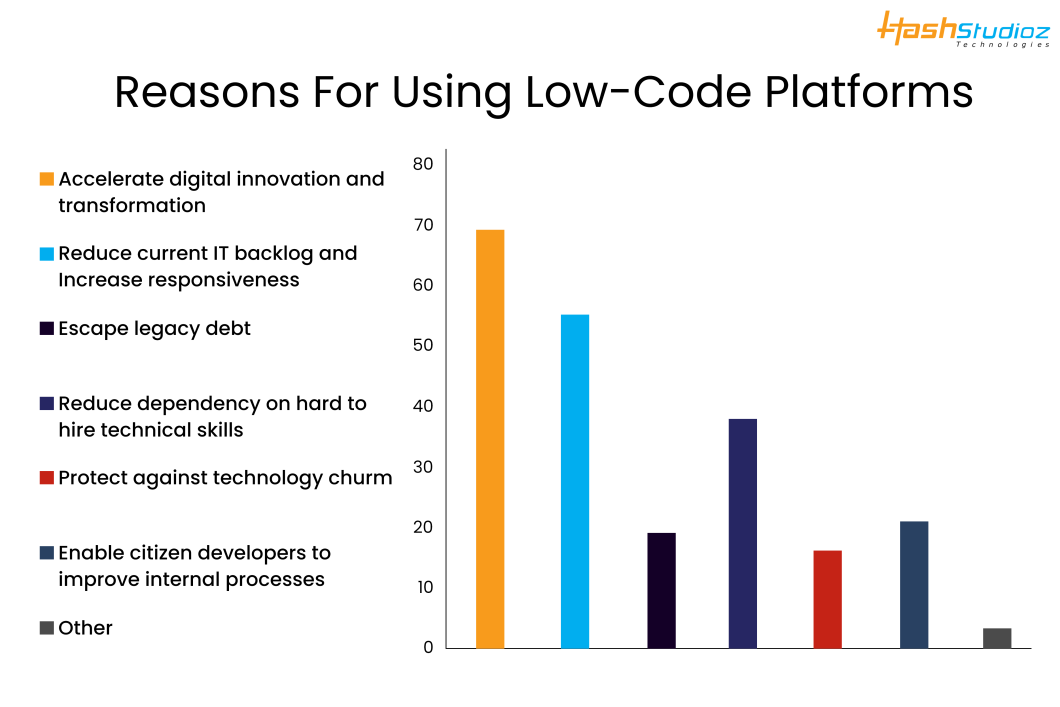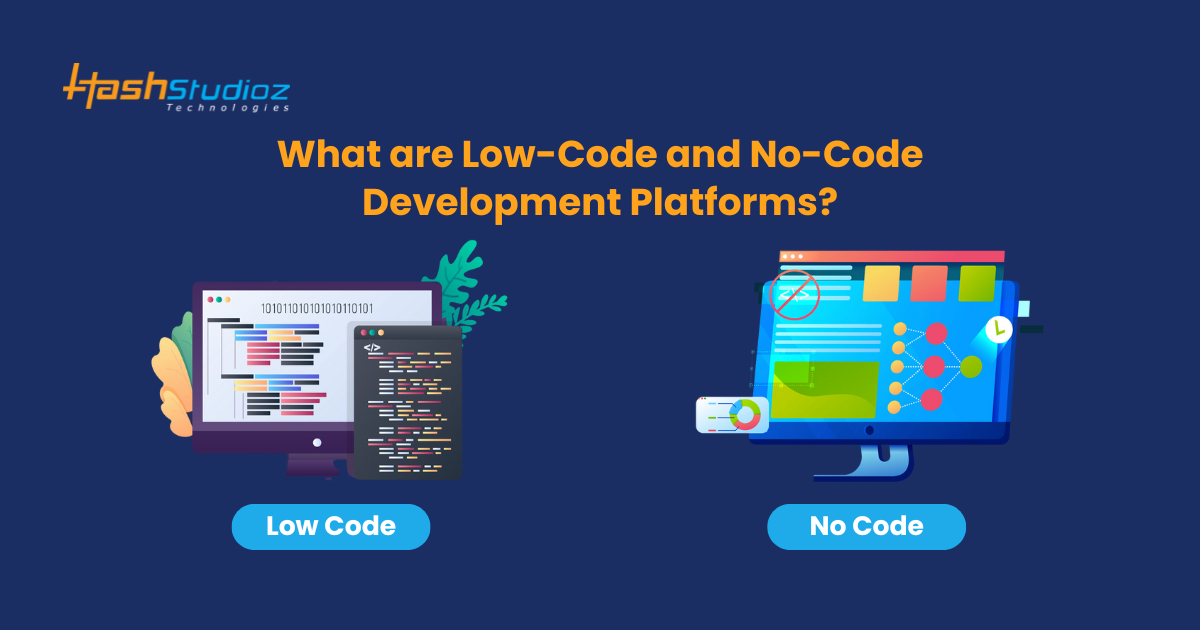According to Gartner, by 2025, 70% of new applications developed by enterprises will use low-code or no-code technologies. Low-code/no-code development platforms are visual software development environments that allow business and citizen developers to drag and drop application components, connect them, and create mobile and web apps. These platforms are frequently used interchangeably with the development approaches they support.
The low-code and no-code modular approaches let professional developers build applications quickly by relieving the need to write code line by line. They also allow non-software professionals such as business analysts, small-company owners, office managers, and others to design and test applications. These people can build applications with very little knowledge of traditional programming languages, machine code, or the development work behind the configurable components of the platform.
Table of Contents
- What Is Low-Code Development?
- What Is No-Code Development?
- How Do Low-Code And No-Code Work?
- Uses For Low-Code/No-Code Development Platforms
- Low-Code Development Platform Vendors
- No-Code Development Platform Vendors
- Benefits Of Low-Code And No-Code Platforms
- Challenges Of Low-Code And No-Code Platforms
- The Future Of Low-Code/No-Code Application Development
- Empower Rapid Development with HashStudioz: Your Trusted Partner in Low-Code and No-Code Solutions
- Conclusion
What Is Low-Code Development?
Low-code development is a software development platform that requires little coding to build applications. It uses a visual development interface (GUI) to process simple logic and features drag-and-drop operations. Low-code development reduces coding time and helps accelerate the development of business applications.
What Is No-Code Development?
No-code development is a platform used to build applications without any coding. Users do not need any coding experience to build applications. It allows programmers and non-programmers to create software applications. This view is closely related to programming languages. The speed and agility to run businesses have increased the demand for no-code development. Let’s look at why we use these platforms now that we have a better understanding of no-code development.
How Do Low-Code And No-Code Work?
In traditional software development, programmers write lines of code to create desired functions and features in a computer program or application. This process requires programmers to have an in-depth knowledge of computer languages and development environments, deployment procedures, and test protocols.
Low-code and no-code platforms combine all the work that goes on behind the scenes. Users visually select and link reusable components that represent certain phases or capabilities (which include the actual code) to construct the required computerized process.
Users can build applications as if they were drafting flowcharts instead of writing line-by-line code for each desired function and capability. These platforms typically have features that allow experimentation, prototyping, testing, and deployment.
This form of app development is also known as point-and-click or just-click development.
Uses For Low-Code/No-Code Development Platforms
Developers can use low-code and no-code platforms to build apps for various commercial or technical purposes when those apps don’t need complex programming or much customization.
You can use these platforms to develop apps that enhance operational efficiency, such as automating manual and paper-based processes or supporting business process management. They also help modernize legacy systems, drive digital transformations, advance cloud migration, and support new technologies like IoT and Artificial Intelligence.
In addition, you can use these platforms to create business apps for both employees and business partners. They also enable you to develop applications for customer engagement.
Low-Code Development Platform Vendors

- Microsoft PowerApps – With Microsoft PowerApps, you can build applications in hours and connect to data in no time. It uses Excel-like expressions to add logic and run on devices.
- Zoho Creator- Zoho Creator is a cloud-based tool that lets you create apps without knowing any code. The main advantage of using Zoho Creator is to accelerate the pace of development.
- Appian – Appian is a low-code automation development platform that helps organizations build their applications and workflows faster.
- Airtable- Airtable is a cloud-based company that allows users to build applications using low-code development. It helps businesses set up use cases such as project management and customer relationship management.
- Kissflow- Kissflow is one of the best workflow automation software development platforms that provides comprehensive solutions. Google Apps like Gmail and Docs are compatible with Kissflow, allowing for a seamless user experience.
No-Code Development Platform Vendors
- Mendix – Mendix is an American no-code development platform that helps test, build, deploy, and iterate applications and show superior success rates.
- Salesforce Lightning – Salesforce Lightning is a no-code development platform that provides building applications that empower applications and turn them into working applications.
- Nintex- Nintex is an end-to-end project management and workflow automation tool for standardizing business processes quickly and efficiently. Anyone can process, manage, optimize, and automate applications without using any code.
- Bubble- Bubble is a visual programming language, a no-code development platform, and an application-building service developed by Bubble Group that enables non-technical individuals to build applications without code.
Benefits Of Low-Code And No-Code Platforms
Fewer code development tools provide many benefits and more people can contribute to the application development process. Additionally, these platforms help companies in increasing their flexibility. The complexity of the application development process is reduced as a result.
There are two other important benefits of the low code platform, i.e. high productivity and low cost as it develops more applications in less time.
The importance of low-code development tools is seen in the graph below. According to research conducted by Freevo, it accelerates digital transformation at 69% and 40% is attributable to reducing dependence on high technical skills.

Challenges Of Low-Code And No-Code Platforms
Although many organizations increasingly adopt these platforms to develop new business apps, they also struggle with the problems and challenges posed by these platforms.
Top management can and usually do lose track of what their employees are developing since these technologies are low-cost and simple to use. This can mean that there is no visibility or monitoring of data generated, used, or even inappropriately exposed in apps. It can also contribute to more shadow IT.
Another potential challenge is how to manage, maintain, and scale these apps, as well as the potentially increased infrastructure and storage costs associated with the proliferation of development activity enabled by these platforms.
Additionally, organizations may find that some tasks aren’t suitable for low-code and no-code platforms, even when used by civilian developers or professional development teams. Using these tools for such tasks could waste resources or lead to failure.
The Future Of Low-Code/No-Code Application Development
The development of software applications is detailed and involves complex processes. However, the introduction of platforms such as no-code and low-code development has reduced the burden and complexity of building applications. These platforms are making software development quick, easy, and accessible. With all these capabilities, the development of applications in the modern world is increasing. Additionally, it facilitates the usage of graphical user interfaces (GUIs), enabling the linking and testing of third-party components and applications. With all these advantages, no-code and low-code are growing and making their mark in all areas.
The future of software development is no-code and low-code. In the future, citizen developers will increasingly use no-code and low-code platforms to build applications. These platforms will provide the necessary governance for developing business functions.
Empower Rapid Development with HashStudioz: Your Trusted Partner in Low-Code and No-Code Solutions
Low-code and no-code platforms aren’t just tools, they’re a transformative shift in how businesses design, develop, and deploy applications. Whether you’re aiming to reduce time-to-market, enable citizen development, or streamline your digital workflows, choosing the right development approach is critical to long-term agility and innovation.
At HashStudioz, we help organizations harness the full potential of low-code and no-code platforms. From solution architecture and integration to customization and scaling, our experts ensure you get a secure, flexible, and future-ready digital foundation.
Connect with HashStudioz today and discover how our low-code and no-code services can accelerate your innovation while reducing development overhead.

Conclusion
Low-code and no-code development platforms have revolutionized how applications are built by enabling faster, more accessible, and cost-effective development. These platforms empower both professional developers and non-technical users to create functional software using visual interfaces, pre-built components, and minimal manual coding. As businesses strive to innovate quickly and adapt to changing market demands, low-code and no-code solutions provide a powerful way to bridge the gap between ideas and execution. Whether you’re a startup looking to launch quickly or an enterprise aiming to streamline operations, adopting these platforms can significantly accelerate your digital transformation journey.

